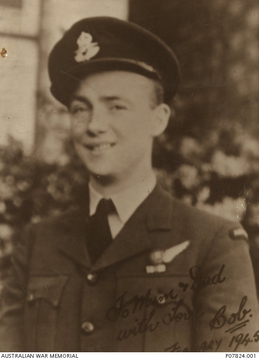
MARTIN, Robert
| Service Number: | 424640 |
|---|---|
| Enlisted: | 6 October 1942 |
| Last Rank: | Flying Officer |
| Last Unit: | Not yet discovered |
| Born: | Sunderland, England, 7 January 1919 |
| Home Town: | Not yet discovered |
| Schooling: | Not yet discovered |
| Occupation: | Not yet discovered |
| Died: | Flying Battle, England, United Kingdom, 9 April 1945, aged 26 years |
| Cemetery: |
Southwick Cemetery, Metropolitan Borough of Sunderland, Tyne and Wear, England |
| Memorials: | Australian War Memorial Roll of Honour, International Bomber Command Centre Memorial |
World War 2 Service
| 3 Sep 1939: | Involvement Flying Officer, 424640 | |
|---|---|---|
| 6 Oct 1942: | Enlisted Royal Australian Air Force, Flying Officer, 424640 |
BIOGRAPHY - ROBERT (BOB) MARTIN
ROBERT (BOB) MARTIN
Bob was born on 7th January 1922 at Castletown, Sunderland, England and his family migrated to Australia arriving in Sydney in December 1926.
Following the outbreak of war in September 1939, Bob, upon turning 18 in January 1940, enlisted in the AIF as a Gunner in the 9th Division and soon thereafter embarked from Sydney for the Middle East on the troopship “Queen Elizabeth” which joined a convoy off Australia’s East Coast. He served with Australian troops in the defence of Tobruk during its seven months siege – the defenders earning the sobriquet, “The Rats of Tobruk”.
With the entry of Japan into the war in December 1941, Australia’s then Prime Minister, John Curtin, recalled Australian troops from the Middle East for the defence of Australia and to meet the imminent invasion of New Guinea by Japanese troops. Back in Australia, Bob took the opportunity to transfer to the RAAF and underwent aircrew training which was completed in Canada. He was then posted to England.
Bob served in 630 Squadron as a Bombardier in Lancaster bombers flying out of the airbase in East Kirkby, Lincolnshire.
Bob was a member of the crew of LANCASTER LE-Z ND 949 which, on the night of 8/9th April 1945, left on a mission to Lutzkendorf, Germany. Returning from the raid after more than eight hours in the air, severe weather conditions were encountered and its home base in East Kirkby, Lincolnshire, was fog bound. The Lancaster was diverted from its base and it is believed that it was trying to make an emergency landing at the nearby Foxton Moor training airfield. At 3.10am on the 9th April 1945, the Lancaster came down in the old Vicarage Garden at Foxton, Leicestershire with the loss of all crew members. It managed to miss the Vicarage and the houses in the area. As well as Bob, five other members of the crew were Australian and the seventh was English.
Bob was buried at Southwick Cemetery, Sunderland, England, on 16th April 1945. Back to where he had left as a 4 year-old 19 years earlier. It seems that Bob as an 18 year old had declared himself as 2 or 3 years older to be certain of joining the Army and so his age in reports has been shown as 26 when, in fact, he was 23.
The fate of Lancaster LE-Z ND 949 had become a frequently told story in Foxton and part of the village folklore. On the initiative of a group of people at Foxton, a plaque honouring the crew was unveiled at a ceremony there on 9th April 2002. Relatives of the crew from England, Australia and Canada were in attendance as well as the local people and the Australian High Commissioner in London arranged for Australian Air Attache, Group Captain Tim Howard to be present.
Submitted 4 September 2022 by Karen Daley









